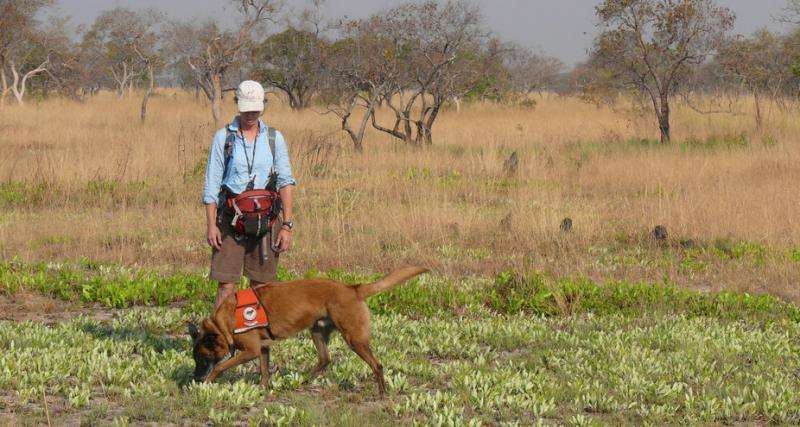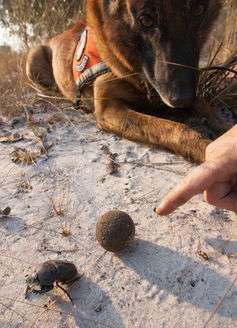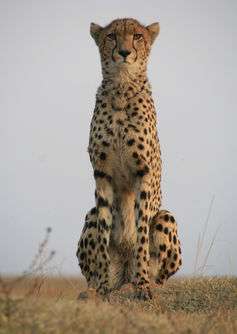Using dogs to find cats—overcoming the challenges of tracking cheetahs

Cheetahs are Africa's rarest big cat. Only an estimated 7,000 individuals are thought to survive in the wild. They're spread across 32 populations covering a vast area of more than 3 million square kilometres. Cheetah densities are never higher than two or three cheetahs per 100km2 and can be as low as one cheetah per 4,000km2. Lion density can be up to about 16.85 lions per 100km2. What's more, in areas where cheetahs are persecuted, due to conflict with livestock and game keepers, they may flee before you are ever likely to even see them.
Cheetahs' rarity and elusiveness poses a problem for conservationists. To conserve the species, we need to know where they still persist, and whether their numbers are increasing or decreasing. But how can we quickly and cheaply estimate their abundance?
Over more than two decades of studying and conserving cheetahs, I have tried many ways of counting them. I have tried simply looking for cheetahs and individually identifying them. This works well. But it requires cheetahs that don't flee from vehicles, an open habitat – and a lot of time and patience. In short, this approach only works on the Serengeti plains and has been key to our long-term Serengeti Cheetah Project which has gathered information on individually known cheetah for decades.
I have tried counting spoor – cheetah footprints left in the dust of dirt roads. Even in the Serengeti, where cheetah densities are at their highest, I had to drive an average of 50km to find just a single spoor. At least 30 such observations are needed for a reliable density estimate.
Remote camera traps can also work in some circumstances and citizen science in tourist areas. But none of these methods work across different habitats, and all need substantial infrastructure and considerable investment in time.
Could the answer to finding cheetah lie with another animal? Dogs have some of the world's most sensitive snouts. We put these to the test in a remote corner of Zambia.
The importance of poop
One of the things dogs can sniff out very successfully – as any canine's owner will know – is poop.

But poop has important properties beside smell. Food, as it passes through the digestive tract and rectum, accumulates DNA from the intestinal and rectal walls, which becomes embedded within the poop. This DNA is a unique genetic signature of individuals. Therefore if you can find cheetah scat, you can extract DNA and identify the genotype of that individual.
Cheetahs defecate at least once a day, hence cheetah scat should occur across a landscape more frequently than the cheetah themselves. It follows that, if you can find enough scat and extract DNA from it, you may be able to estimate the numbers of individual cheetah in the population. Finding scat, rather than cheetah, has the added advantage in that scat doesn't run away.
So far, so good. But there is a flaw in this plan. Cheetahs, who are largely non territorial, don't defecate in nice, easy to find, prominent locations. As a result, their scat is extremely difficult to detect.
Harnessing the power of the canine snout
This is where the poop-detecting power of the canine snout comes into play. Domestic dogs are increasingly playing an important role in conservation. Organisations such as Working Dogs for Conservation, and Green Dogs specialise in training domestic dogs for conservation work. They harness the dogs' natural poop detection ability, by training them to find poop of a particular species, signal their trainer when they have found it, and, above all, resist the temptation to eat any poop they find.
Could domestic dogs be the key to counting cheetah? Together with my colleagues from the Zambian Carnivore Programme and the Zambia Department of National Parks and Wildlife, we teamed up with Working Dogs for Conservation and Green Dogs to put domestic dogs to the test. This is what brought a team of large carnivore conservationists, two dogs (Faust and Pepin) and their trainers to a remote corner of western Zambia, where a low density, but unknown, population of cheetah still survives in and around the Liuwa Plain National Park.
Disappearing poop
At first, the dogs struggled to find scat on our pre-designated dog walking transects. This was when we started to notice the conspicuous absence of the dogs' poop around our camp. On closer inspection, we were alarmed to discover that, no sooner had a new deposition of poop been made, a small army of dung beetles appeared and started rolling it away in large bundles.

A large healthy pile of steaming dog poop could disappear completely in a matter of hours. Having been an observer of cheetah poop in the Serengeti over many years, this was a first for me, and it caused me a substantial amount of anxiety.
Fortunately, as the dogs moved south, they started to find cheetah scat laden with bone and hair. This, presumably, was much less appealing to a passing dung beetle.
In fact, the dogs turned out to be very successful at finding cheetah scat. In all, they found 27 scats over a survey area of 2,400km2. Humans, on similar transects looking for spoor, found none. This neatly demonstrated the superiority of the canine snout over the human eye when it came to detecting the presence of cheetah.
Estimating population size
These scats were combined with a number of opportunistically collected scat. The DNA extracted from the scat samples were of poor quality, and so interpreting the genotypes wasn't always easy.
However, we were able to generate an estimate of between 17-19 cheetah in the area, with a density of 6-7 individuals per 1000km2. The preliminary estimate of genetic effective population size was low, at just 8-14 individuals, and requires further investigation.
Many areas where cheetah still survive are remote and difficult to access. Prior to this study, there were no viable methods for obtaining reliable information on cheetah abundance in most of these areas. The beauty of using detection dogs was that surveys could be conducted on foot, and the whole survey took not much more than three weeks, although genetic work could take substantially more time.
Our study, therefore, provides an important step forward in our ability to detect cheetahs across large landscapes, monitor them and assess population trends. Such information is critical for mobilising conservation action and resources to halt the global decline of this elusive and secretive big cat.
Provided by The Conversation
This article was originally published on The Conversation. Read the original article.![]()



















